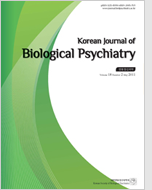
- Past Issues
- e-Submission
-

2021 Impact Factor 1.766
5-Year Impact Factor 1.674
Editorial Office
- +82-01-9989-7744
- kbiolpsychiatry@gmail.com
- https://www.biolpsychiatry.or.kr/

2021 Impact Factor 1.766
5-Year Impact Factor 1.674
Korean Journal of Biological Psychiatry 1996;3(2):288-94. Published online: Feb, 1, 1996
Background :
Most studies of the pituitary hormonal responses to electroconvulsive therapy(ECT) have used limited blood sampling schedules. Little is known about the precise sequence of neuroendocrine events immediately following on ECT application, or about the regulation of the hormonal responses.
Methods : Blood was sampled at three minute intervals from eleven patients(two schizophrenics and nine affective disorder patients) undergoing ECT. Each sample was immunologically assayed for arginine vasopressin(AVP), adrenocorticotropic hormone(ACTH), prolactin(PRL), and cortisol. Baseline hormone concentrations and several measures of response were determined for each hormone. The temporal and quantitative relationships among the hormonal responses were determined. Correlations were calculated between seizure duration and secretory responses.
Results : All four hormones demonstrated significant secretory responses to ECT, with AVP increasing from 1.2 to 3.3pg/ml(P<0.001), ACTH from 5.4 to 32.3fmol/ml(P<0.001), PRL from 21.8 to 102.2ng/ml(P<0.005) and contisol from 20.1 to 30.1ug/dl(P<0.001). The three pituitary hormones showed consistent time courses of secretion with onset of responses by three minutes but clearly differing peak times of 3, 6, and 12-15 minutes for AVP, ACTH, and PRL, respectively. Cortisol began to rise after 6minutes and peaked between 20-30minutes. There were no significant correlations between seizure duration and any of the secretory response measures.
Conclusions : 1) The pituitary hormone response to ECT is sequential rather than synchronous. 2) The AVP response was extremely rapid and more massive than those of any other hormones. 3) The ACTH response of this study was more rapid and more robust than that revealed by the most of poast studies. 4) The results strongly suggest that the pituitary hormones are released as a result of the seizure rather than the electrical stimulus. 5) The sequential pattern of responses suggests that neuroendocine feedback-regulatory mechanisms determine the response profile.
Keywords Electroconvulsive therapy;Pituitary hormone;Hypothalamic-pituitary-adrenal axis.